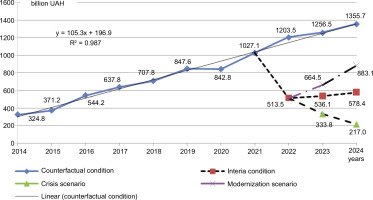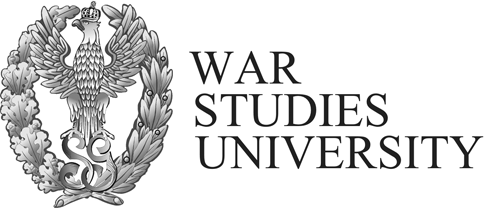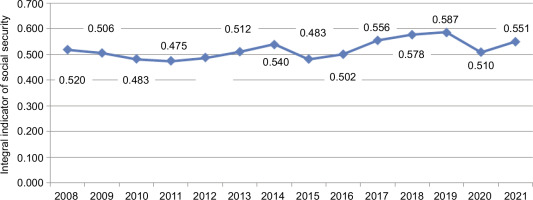Introduction
Launching an aggressive unprovoked war against Ukraine, the Russian Federation (RF) caused the greatest large-scale humanitarian crisis in a European country since World War II by killing and mutilating thousands of Ukrainians and leaving millions of people without accommodation and livelihood.
To begin with, the Russian-Ukrainian war has a terrible humanitarian dimension (Liadze, et al., 2023). Moreover, the economic costs of the war will be felt mostly in Europe, but the effect on the global economy is expected to be sizeable as well (Ersoy, 2022). Thus, the war has significantly modified the regional and international security environment, and the current world order is being challenged (Ionita, 2023).
The relevance of the search for ways of overcoming the social crisis associated with the conditions of the long-term war of aggression against Ukraine is increasing, while the opportunities for ensuring social security are drastically dwindling. Social security in general is a critical component of the social policy of Ukraine, and the current status of its humanitarian component evokes the need for the provision of assistance by the international community.
In spite of the fact that social security issues have traditionally been under researchers’ scrutiny, scientific discussions normally focus on the essence of social security and how to ensure it (Buniak, 2022; Petkun, 2022), assessment methodologies of different levels (Bondarevska, 2022; Boreyko and Paranytsia, 2020; Chechel and Kharlanova, 2019; Hnydiuk and Romanovska, 2022) as well as financial and economic mechanisms of ensuring it (Fradynskyi, 2022). Despite the long-lasting war in Ukraine, there are still no publications related purely to the coverage of the war or humanitarian problems of social security. We found just one scientific paper on the social aspects of volunteering activity (Say and Malynovska, 2022) and one publication on the norms of international humanitarian law in the activity of peacekeeping missions (Piskun and Dudnik, 2022).
Nevertheless, the war has already become the object of research with respect to various aspects related to the humanitarian component of the situation of the civilian population in both Ukraine and abroad. Numerous publications showing the war from different perspectives have appeared. In this regard, Anjum et al. (2023) exposed how the mental health and well-being of Ukrainian civilians, asylum seekers, and refugees are affected by the war-caused limbo. The economic costs of the Russian-Ukrainian war were presented in the study by Liadze et al. (2023). Moreover, the implications of the Russian-Ukrainian war on global and regional food security were analysed (Abay et al., 2023; Zhou et al., 2023). Furthermore, threats to energy security have been examined (Ersoy, 2022; Zhou et al., 2023).
Therefore, the goal of this research is to analyse the humanitarian aspects of social security restoration in Ukraine. The research adheres to the following procedure: first, the principles of ensuring social security in Ukraine were considered. Next, using the author’s assessment methodology, the actual condition of ensuring it in the pre-war period was explored. Then the losses in the social domain in Ukraine resulting from Russia’s military aggression and the need for emergency humanitarian aid were evaluated. Finally, the mechanisms of providing the humanitarian component of social security during the war as well as the principles of international humanitarian aid were analysed.
The present research has limitations, caused by the fact that a major part of the social-economic statistical data on Ukraine for the 2022–2023 period is unavailable due to understandable reasons. Nonetheless, the special relevance of this article stems from the fact that it aims to launch a global discussion on the role and place of humanitarian aspects in ensuring social security in a state suffering from armed aggression. Hence, the article promotes the idea that a united international community is influential in overcoming the humanitarian crisis and contributing to the search for inclusive ways of humanitarian aid provision for the sake of restoring a satisfactory level of social security. Besides, the research may become a useful institutional initiator of an international cooperation policy for the sake of better realizing the nature of the occurrence of social threats in modern society, with the aim of coordinating equitable integrated social protection projects.
The principles of ensuring social security in Ukraine
In peaceful pre-war life, social protection of residents guaranteed the basic set of transfers aimed at ensuring an acceptable employment rate and level of income for pensioners, unemployed, or disadvantaged employed persons. The overall accessibility of the main social services in the fields of healthcare, education, food safety, housing, water supply, and sanitation, as well as in other fields determined by the national priorities, was provided by Dzioba and Stavnycha (2020).
In the modern definition of national security in Ukraine, protection of state sovereignty, territorial integrity, and democratic constitutional order are at the forefront, followed by other national interests of Ukraine, which include vital social interests of individuals, society, and the state (Table 1).
Table 1
The core elements of the legislative definition of specific types of security.
Social security in Ukraine is considered to be a complex multi-criteria social and economic phenomenon pre-determining the safety of life and activity of individuals and society. It is accompanied by a sustainable social system of ensuring individual safety and development; social protection of individuals; protection of vital objectives, ideals, values; interests of social entities; preservation, reproduction, and development of human and labour capacity; and support of the life-and-activity system.
The status of social security in Ukraine in the pre-war period
The following components of social security are subjected to measurement: standard of living and quality of residents’ life; degree of subsistence resources distribution; social and labour relationship; accessibility of educational, healthcare, cultural, and recreational services; social protection; personal safety; social resources; social capital; and rights and freedoms (Table 2).
Table 2
The hierarchical model for assessing the level of social security in Ukraine.
[i] Source: Developed according to Yakymchuk et al. (2020).
To analyse the status of social security in Ukraine during the peaceful period based on each component, we developed the information subsystem for identifying and determining specific social security level measurement indicators, differentiating the indicators by their hierarchical levels. The integral social security level indicator was determined via the additive rollup of the indicator values using statistical and sociological information. In the representation of the input indicators of the information set {Xi} with different units of measurement, for additive aggregation, the vector of input attributes {X1, X2, X3} was replaced by the vector of their standard values {Z1, Z2, Zm}.
The standardized values of input indicators (Zij) were calculated as follows:
where Xij is the actual value of the j indicator by the i component
Subindices of social security level were calculated by each internal component:
The integral value was calculated as an arithmetic mean based on subindices following the ratio, provided each component is equal in ensuring social security:
provided components are not equal,
where Wi is the weight of the i component. Weight factors were determined by experts using the hierarchy analysis method (Saaty, 2008).
For the additive rollup following the algorithm of a multi-dimensional average simple value (4), the effect of specific subsystems (ΔIi, relat.) on the change of the integral indicator was determined by the proportionate distribution following the ratio:
where ΔISS,relat is the speed of the integral social security indicator increase (decrease);
where ISS,t,t–1 are levels of the integral indicator, respectively, for the years t – 1 and t; ΔISS is the absolute change of the integral indicator over the respective period: ΔISS = ISS,t – ISS,t–1; ΔIi is the absolute change of the i subindex over this period.
Determination of the relative effect of subindices on the speed of the integral indicator changes in general ensured identification of the core factors changing the level of social security, for both each specific year and the whole period in question (Table 3).
Table 3
The dynamics of subindices and the integral social security indicator in Ukraine over the 2008–2017 period.
Considering the fact that the boundaries of the integral indicator changes are within the interval (0–1), the qualitative characteristics of social security levels were determined by the attributive scale (Table 4):
Table 4
Attributive scale for determining the level of social security.
| R | Level of social security | Quantitative assessment |
|---|---|---|
| 1 | Very low | 0.0–0.2 |
| 2 | Low | 0.2–0.4 |
| 3 | Moderate | 0.4–0.6 |
| 4 | High | 0.6–0.8 |
| 5 | Very high | 0.8–1.0 |
Thus, despite an increase of 5.96% over the observation period, the general level of social security in Ukraine during the period before the full-scale Russian invasion can be assessed as moderate (Figure 1).
The losses recorded in Ukraine’s social field as a result of Russia’s military aggression
At the beginning of 2014, a hybrid war was launched by the RF against Ukraine; the autonomous region (AR) of Crimea was annexed, and parts of Donetsk and Luhansk regions were invaded. As a result of the hybrid aggression, at the end of 2021, about 7% of the Ukrainian territory was under temporary occupation. Regarding the human losses resulting from the war, 3,375 people were killed, about 8,000 civilians were injured, and over 1,177 persons became internally displaced (Radio Svoboda [Ukr.], 2021). The rights of Ukrainians are violated in the occupied territories;they are subjected to political repression, and they have limited opportunity to leave (unless based on Russian direction) and communicate with their relatives who have left the occupied territories. Further, studies at schools and higher educational institutions have been ideologically reformatted to suit Russian narratives. Destruction and decay of many enterprises have led to the loss of jobs and reduced residents’ income (Antoniuk, 2022).
On 24 February 2022, the RF launched a full-scale invasion along the full length of common borders, as well as from the territory of the Republic of Belarus. In the future, Ukrainians, as well as the whole global community, will learn the actual scope of the humanitarian catastrophe caused by the war, since the hostilities are still going on now. Ukrainian cities and villages are destroyed every day with non-selective missile strikes and drone attacks. Peaceful civilians are killed in the attacks; also, civilians are kidnapped, tortured, and executed without court judgments in the occupied territories. Between February 2022 and July 2023, almost 10,000 civilian deaths and 18,500 injuries were reported (Office of the High Commissioner for Human Rights (OHCHR), 2023).
Returning to the pre-war status will require current and capital repairs, reconstruction of residential buildings and construction of new ones, restoration of adjacent areas (greening, arrangement of playgrounds for children, etc.), and procurement of furniture and consumer electronics. The total direct damage to buildings and infrastructure across sectors is estimated at approximately US$152 billion. The most affected sectors are housing (almost US$56 billion, or 37% of total damage), transport (almost US$34 billion, or 22%), commerce and industry (almost US$16 billion, or 10%), energy (almost US$11 billion, or 7%), and agriculture (US$10 billion, or 7%). Across sectors, Donetska, Kharkivska, Luhanska, Zaporizka, Khersonska, and Kyivska oblasts have sustained the greatest damage (World Bank, Government of Ukraine, European Union and United Nations, 2024).
Within the energy complex of Ukraine, the electricity sector is the most affected one. Russia keeps staging targeted large-scale attacks on power generation, transmission, and distribution facilities. The attacks have resulted in considerable damage to Ukraine’s integrated energy system, including power generation and transmission infrastructure. Damage as of 31 December 2023 was estimated at US$10.6 billion; this excludes damage to the district heating sector, which is estimated at almost US$2.1 billion (World Bank, Government of Ukraine, European Union and United Nations, 2024).
Moreover, civil NPPs in war zones can be weaponised and exploited by the hostile forces not only for impeding energy supplies (and thus shattering the public morale of the adversary) but also for blackmailing and coercing the decisionmakers of the attacked state and their international allies with a vision of man-made nuclear disaster (Przybylak, 2024).
War has resulted in the reduction of the purchasing power of Ukrainians by almost 40% (Pyshchulina and Markevych, 2022) due to reduced household income or even complete loss of household income, making the food safety of a considerable percentage of Ukrainians dependent on humanitarian aid. The reduction of the real GDP of Ukraine by 29.1% in 2022 may have caused the population poverty rate to increase in 2023 by up to 60% (World Bank, 2022); this causes food safety risks for vulnerable households and communities. In urban areas, more affected people can be traced than in rural areas; they provide information about lack of food, water, power, and heating, thus contributing to acute malnutrition (World Food Programme [WFP], 2022).
Assessment of the losses in the agro-industrial sector of Ukraine must include analysis of changes in economic flows, lost production volumes, and income along the whole foodstuff supply chain as well as the level of resource capacity preservation (Svydruk et al., 2022). To perform the modelling of the food safety restoration opportunities for the nearest future, we calculated the counterfactual condition of the agro-industrial sector, taking into account the GDP rate in Ukraine in 2021—5,459.6 billion UAH; food market assessment—1,027.1 billion UAH; real growth forecast in 2022—at the rate of 3.4%; and an inflation rate of 5% (National Bureau of Statistics [NBU], 2022). Thus, the counterfactual condition was 1,203.5 billion UAH based on our assessment. The expected losses amount to 168.5 billion UAH in the prices of 2020 (World Bank, 2023). By applying adjustments based on the agricultural products manufacturing growth rate (21.85%) and inflation rate (14.4%) in 2021, we assessed that the losses amounted to 389.8 billion UAH. With an inflation rate of 29.1%, the losses for 2022 can be estimated at 513.6 billion UAH, or 50% (inertia status in Figure 2).
Figure 2
Scenario prospects for the dynamics of development of Ukraine’s agro-industrial sector. Source: Author’s calculations.

The modelling, made with a high level of reliability (R2 = 0.987), proves that a food catastrophe may be on the way if the military aggression continues for a long duration. At the same time, the termination of the hostilities will not considerably improve the situation. The high level of material, human, and logistic losses as well as physical infrastructure damage will require state regulation and creation of special conditions for the post-war restoration of the agricultural industry of Ukraine.
We also include the problem of land mine placement in territories with active hostilities and newly liberated areas in the aggregate losses of Ukraine’s social security system. Assessing potential demining costs, Mind Intelligence (2022) calculated that the Ministry for Emergencies of Ukraine would need up to $10 billion for it.
Ukraine’s need for emergency humanitarian aid
Humanitarian problems have been the most acute difficulties in the areas with active hostilities. Elderly people, people with disabilities, and children appeared to be particularly vulnerable due to their limited mobility, the effect of strikes, and aggravation of economic problems. In government-controlled territories, the acuteness of the needs was lower and mainly centred on internally displaced persons (IDPs) who needed humanitarian assistance (Pyshchulina et al., 2022). In the areas affected by hostilities, the mechanisms of protection of vulnerable children and families were violated, and the risks of child morbidity, violence, family divorce, children trafficking, and being blown up by unexploded ordnance increased. The mental health of about 1.5 million children is threaten due to the horrors of war; for millions of children, school education has terminated, since 2,300 schools are affected by the bombardment, and at least 286 are completely destroyed (World Vision International, 2022).
Russia’s war against Ukraine has caused the largest wave of refugees after World War II. As of December 2023, an estimated 6.5 million people were recorded globally as refugees (United Nations High Commissioner for Refugees [UNHCR], 2024). The invasion has resulted in increased cases of trauma and serious injuries, leading to a rapid rise in the number of people with disabilities. IDPs and returnees face many challenges linked to their socio-economic situation; they face employment challenges, scarcity and geographical mismatch of vacancies, reduced wages, and barriers in the labour market, particularly women and vulnerable subgroups, such as young people and persons with disabilities. Demobilisation, reintegration, and socio-economic support are needed to address the needs of veterans and their families. Risks of gender-based violence, including war-related sexual violence, human trafficking, and partner violence, have increased since February 2022 (World Bank, Government of Ukraine, European Union and United Nations, 2024).
Russia’s military aggression against Ukraine prompted different countries to organise emergency humanitarian aid for Ukrainians. In particular, the Council of Europe, within the approved new European Union (EU) Action Plan for Ukraine for 2023–2026, presupposes €50 million for the projects related to recording Russia’s war crimes and minimising the humanitarian consequences of the Russian aggression. In 2022, the United Nations (UN) sent more than $4.5 billion to Ukraine for the accommodation and nutrition of IDPs, restoration of food safety, healthcare, provision of drinkable water, means of sanitation and hygiene, payment of multi-purpose cash assistance, child protection, counteracting gender-based violence, and anti-mine actions. From the consolidated budget, the Organisation for Security and Co-operation in Europe (OSCE) was able to implement eighteen projects, with a total cost of €1.2 million. In addition, eighteen non-budget projects (at the expense of specific OSCE member states) with a total cost of €37.4 million were implemented (United Nations International Children’s Emergency Fund [UNICEF], 2023).
The UNICEF (2023) has supported 1,005 healthcare institutions in Ukraine, in particular 312 perinatal centres, with a total amount exceeding $35.8 million. Psychosocial support activities aimed at overcoming the war consequences and forced displacement have embraced almost 3 million children; 352.1 thousand women and children have received assistance from the services responding to gender-based violence; 684.9 thousand children have been provided with winter clothes, non-food items, and means of protection, and over 300 children with disabilities have been provided with rehabilitation means. Support has been provided to 1.5 million children in terms of access to education, and safe spaces have been created in schools. In 2023, UNICEF humanitarian management entities continuously expanded adaptive response to emergencies in Ukraine, in particular delivery of critical goods, provision of vital services, and improvement of social services.
State and local authorities in Ukraine cooperate with UNHCR insofar as provision of humanitarian aid (if accessible) for the most vulnerable strata of the population, including temporary accommodation, financial assistance, and essential supplies.
Conclusions
Social security constitutes a precondition not just for the social but also for the economic progress of the country. Ensuring the social security of an individual, society, and the state constitutes the central concept around which the activity of all branches of power should be structured. Despite this, it was determined that social security in Ukraine is presently not a priority national security field that places the protection of state sovereignty, territorial integrity, and democratic constitutional order in the foreground.
It has been established that a low level of economic development of the Ukrainian economy in the pre-war period was accompanied by citizens’ unsatisfactory standard of living, which, in turn, led to the development of certain social threats. The author’s suggested methodology for assessing social security ensured an adequate assessment of its level as well as the identification of the factors of influence and the trends in the social security dynamics. This could be used as a methodological foundation for the development and implementation of a system of state social security regulation. A moderate level of social security was identified, with a clearly manifested link to the general regular features of social and economic development of Ukraine and the unambiguous effect of bifurcation points (hybrid aggression of the RF in 2014 and effect of the pandemic in 2020).
The actual volume of the humanitarian catastrophe caused by the war cannot be assessed now, since RF’s aggression is still ongoing. At the same time, the analysis of open information sources gives grounds to voice statements about the catastrophic situation in the field of social security of the Ukrainian society caused by large-scale damages or a complete destruction of residential stock facilities, social infrastructure facilities (in particular, the educational, healthcare, and energy infrastructure), environmental consequences, an increased level of residents’ poverty, and food safety risks.
The identification of Ukraine’s needs for emergency humanitarian aid constitutes a necessary step towards overcoming the humanitarian crisis consequences, particularly in the de-occupied regions or the ones where active hostilities went on for an extended period. The major problems lie in the violation of the mechanisms of protection of vulnerable groups of residents, a large wave of refugees, increased risks of contracting a disease, interruption of education for children, violence, and being blown up by unexploded ordnance.
International humanitarian aid has addressed the problems of the acute social crisis phase. With the UN coordination, funding for urgent accommodation and provision of food to refugees, for healthcare, for drinkable water and sanitation, for child protection, and for demining has been directed to Ukraine. The UNICEF has made arrangements to restore the operation of healthcare institutions and provide psychosocial support for children and women. Particularly precious for adapted implementation in the Ukrainian legal field is the Polish experience of arranging social assistance that combines the principles of social justice and own financial possibilities, through the adoption of legal decisions aimed at providing assistance to refugees.
Today, it is important to develop approaches to the study of the actual situation in the social sphere under the conditions of a long-term war. The lack of reliable statistical data prompts the search for adequate ways to understand the real level of social security. Based on our methodology, it will be possible to return to the comprehensive assessment and forecasting of the humanitarian aspects of social protection in post-war Ukraine.





